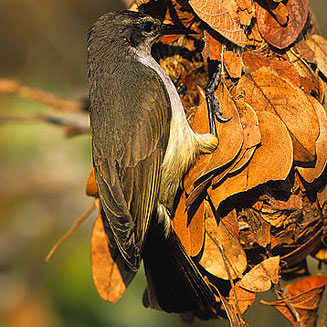|
Anthreptes longuemarei (Western
Violet-backed sunbird)
Blousuikerbekkie [Afrikaans]; Dzonya, Tsodzo (both are
generic names for sunbird) [Shona]; Violetrug-honingzuiger [Dutch]; Souimanga
violet [French]; Violettmantel-nektarvogel [German]; Beija-flor-violeta
[Portuguese]
Life
> Eukaryotes >
Opisthokonta
> Metazoa (animals) >
Bilateria >
Deuterostomia > Chordata >
Craniata > Vertebrata (vertebrates) > Gnathostomata (jawed
vertebrates) > Teleostomi (teleost fish) > Osteichthyes (bony fish) > Class:
Sarcopterygii (lobe-finned
fish) > Stegocephalia (terrestrial
vertebrates) > Tetrapoda
(four-legged vertebrates) > Reptiliomorpha > Amniota >
Reptilia (reptiles) >
Romeriida > Diapsida > Archosauromorpha > Archosauria >
Dinosauria
(dinosaurs) > Saurischia > Theropoda (bipedal predatory dinosaurs) >
Coelurosauria > Maniraptora > Aves
(birds) >
Order: Passeriformes > Family: Nectariniidae
Distribution and habitat
It has two separate populations above and below the
equator; one extending in a band from Senegal to Sudan and the other occurring
across southern DRC, Angola, southern Tanzania, Zambia, Malawi and southern
Africa. Here it is uncommon and localised in north-eastern Zimbabwe and in
patches in central and northern-western Mozambique. It generally prefers the
canopy of mature miombo (Brachystegia) woodland and large stands of
mahahobohobo (Uapaca), occasionally moving into suburban and farm gardens
in winter.
|
 |
|
Distribution of Western violet-backed sunbird in southern Africa,
based on statistical smoothing of the records from first SA Bird Atlas
Project (©
Animal Demography unit, University of
Cape Town; smoothing by Birgit Erni and Francesca Little). Colours range
from dark blue (most common) through to yellow (least common). |
Food
It mainly eats arthropods supplemented with nectar, doing
most of its foraging in the canopy, gleaning prey from leaves and branches but
occasionally hawking insects aerially. The following food items have been recorded
in its diet:
- Arthropods
- Nectar
- Aloe
- Kniphofia (torch lilies)
- Erythrina abyssinica (Red-hot-poker coral-tree)
- Faurea rochetiana (Broad-leaved beechwood)
- Loranthaceae (mistletoes)
- Leonotis leonurus (Wild dagga)
- Bauhinia variegata (Butterfly tree)
- Tecoma capensis (Cape-honeysuckle)
- alien plants
- Callistemon viminalis (Weeping bottlebrush)
- Spathodea campanulata (African flame tree)
Breeding
- The nest (see image below) is built solely by the female, consisting of an
oval-shaped structure with a side entrance, which often faces into the nest
tree. It is usually made from grass and other plant fibres bound with spider
web and decorated with dead leaves, with an interior lining of fine grass
stems and plant down. Typically it is placed amongst dense seed pod clusters
in a leafless tree, although it has been recorded to use creepers on the
sides of buildings or even sociable spider nests.
 |
|
|
Western violet-backed sunbird female at its nest,
Mutinundo, Zambia. [photos
Johann Grobbelaar ©] |
|
- Egg-laying season is from about August-December, peaking from
August-October.
- It lays 1-3 dark buff eggs, which are covered in strange scribbles and
lines, which resemble signatures.
- Very little known is known about the chicks, other than that they are
fed by both parents.
Threats
Not threatened globally, but its population in Zimbabwe has
severely decreased due to the ongoing destruction of mature miombo (Brachystegia)
woodland. It unfortunately dislikes young and immature woodland types, so this
deforestation is definitely cause for concern.
References
-
Hockey PAR, Dean WRJ and Ryan PG 2005. Roberts
- Birds of southern Africa, VIIth ed. The Trustees of the John Voelcker
Bird Book Fund, Cape Town.
|
